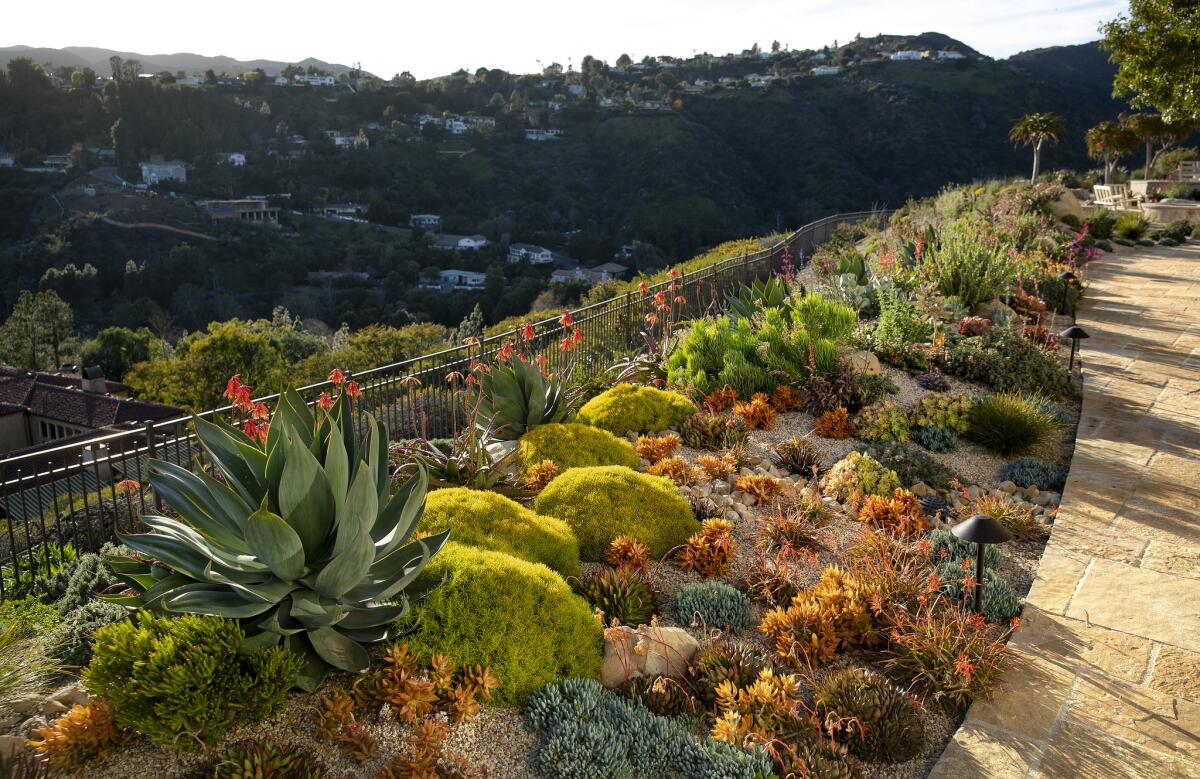Look at this stunning rain garden landscape in Brentwood
Money can’t buy everything, but when you’re transforming 25,000 square feet of lawn, palms and thirsty, flammable shrubs into a water-saving oasis of succulents, edibles and California-friendly plants — complete with 11 rain collection tanks for irrigation — well, a little paper green always helps.
The hilltop landscape surrounding one gorgeous home in Brentwood’s Mandeville Canyon will be the crowning piece of the Assn. of Professional Landscape Designers’ eight-garden tour taking place April 13, and the only one that will include guided walks to explain the sustainable features to visitors.
The designers won’t reveal the price tag of this rain garden renovation, which was nearly three years in the making, from planning and permitting to 13 months of construction. But the results were so spectacular it won the American Society of Landscape Architects’ national Quality of Life Award of Merit in 2018 in the “Projects over $300,000” category.
“That gives you some idea of the cost,” said Marilee Kuhlmann of Urban Water Group in downtown Los Angeles, who designed the project with her colleague, landscape architect Tom Rau. But she and Rau say there are plenty of things that mere (financial) mortals can copy in their yards, even with more modest means.
The pair’s focus in this project was on creating landscapes that are beautiful and inviting even in persistent drought conditions, with shady spots, meadows of nonflammable grasses, and blankets of color from leaves and blooms.
That meant using plants like California natives or “California climate appropriate” plants from dry, hot regions such as the Mediterranean, Australia and South Africa, Kuhlmann said.
Landscape designer Johanna Woollcott of Wild Gardens L.A. created the succulent quilt of brilliant color and texture along the back of the 7,500-square-foot house. Native plant specialist Carol Bornstein, who literally wrote the book on “California Native Plants for the Garden,” advised on the selection and planting of (mostly) native perennials.
Such plants adapt to the heat by sending their roots deep in the ground: They get their water in the wet winter months so they can withstand the parched heat of summer. Designers also mixed those perennial plantings with a liberal selection of succulents, which carry their water in their leaves, for a garden that will thrive without heavy irrigation once established. It is estimated that water consumption ultimately will be decreased by 80%.

The yard is so big that it has its own stations, including an edible garden with vegetables, berries and fruit trees on one end of the property and an oak woodland at the other. Here native oaks were kept in place to create a shaded spot with stone benches, where you can sit and stare out at the rest of the yard, or the Channel Islands on the horizon.
There’s also a meadow of native field sedge (Carex praegracilis) near the pool, which grows about 12 to 14 inches tall and can be “mowed” once a year with a weed whacker. The meadow conceals eight underground collection tanks for water that runs off the home’s 7,500-square-foot roof. (Two others are buried in the vegetable garden.)
It’s called a rain garden because rainwater is diverted into the tanks with a series of rain gutters and pipes. Then a water pump sends the water back out as needed for drip irrigation. A cellphone app allows the user to monitor the fullness of each tank and control the yard’s drip irrigation system.
The tanks, which hold a total of 23,000 gallons of water, got plenty of use during the recent rains, Kuhlmann said. The tanks were emptied five times during February’s record rains, but the water was dispersed slowly through the drip system so it had a chance to soak into the ground rather than run off down the hill.
This landscape design is much more than a pleasing collection of plants (mostly furnished by Native Sons Nursery near San Luis Obispo), Kuhlmann said. “It’s a biodiversity center, designed to maximize the number of species supported by the landscape.”
The project ignored chemical fertilizers in favor of organics and bringing in better soil with beneficial mycorrhizal fungi to build healthier roots. It meant installing an owl house and raptor perch along the edge of the property line to encourage raptors to prey on gophers who were feasting on the new plants.
There are also small stone ponds around the property, just an inch deep, to collect drinking water for pollinators and other critters who wander the hills around the home. Kuhlmann installed little lights by each watering station, so humans sitting outside at night can see what kind of wildlife is sipping at the ponds.
These are all things that can be done on a smaller, more affordable scale, Kuhlmann said. The owners purchased one 5,000-gallon and 10 1,780-gallon tanks for this project, but the supplier, Bushman, also makes much smaller tanks, such as a 660-gallon model that costs about $510 and can hold the runoff from a 1,000-square-foot roof after 1 inch of rain.

That probably won’t be enough to water your entire yard, but it can be used to deep-water trees that don’t get enough moisture from drip irrigation, Kuhlmann said.
It’s all about creating a sustainable yard in our urban environment, she said, “a beautiful place where you can come to unwind.”
The Greater Los Angeles District of the Assn. of Professional Landscape Designers’ SEE (“Succulent Edible Ethical”) Garden Tour
When: 9 a.m. to 4 p.m. April 13
Where: Eight landscapes in West Los Angeles, Santa Monica and Brentwood
Cost: $60, reduced price for members and students
Info: tinyurl.com/y5tzaeky




